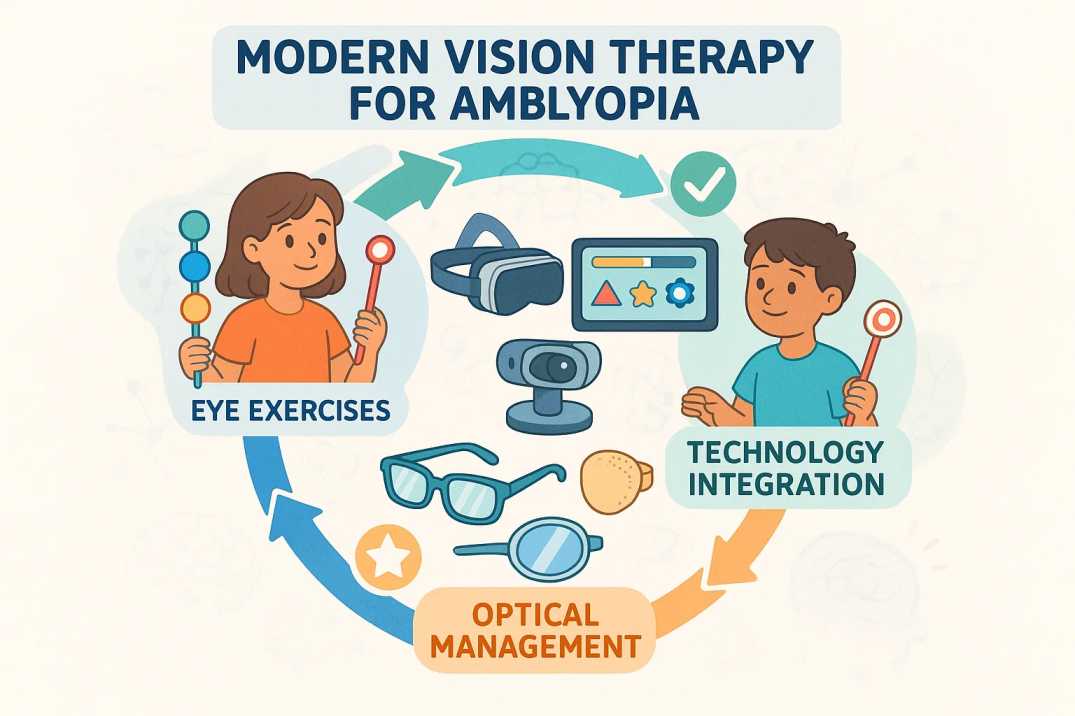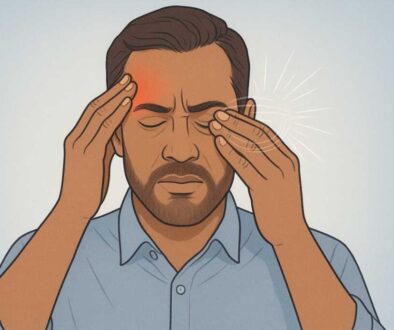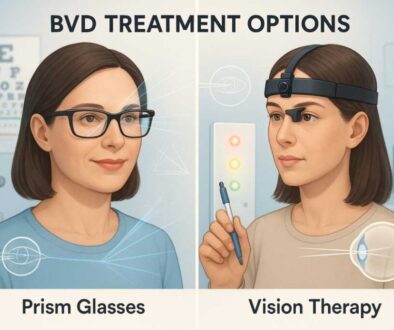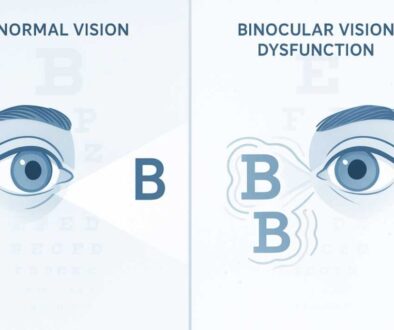Amblyopia Therapy: Vision Training vs Surgery
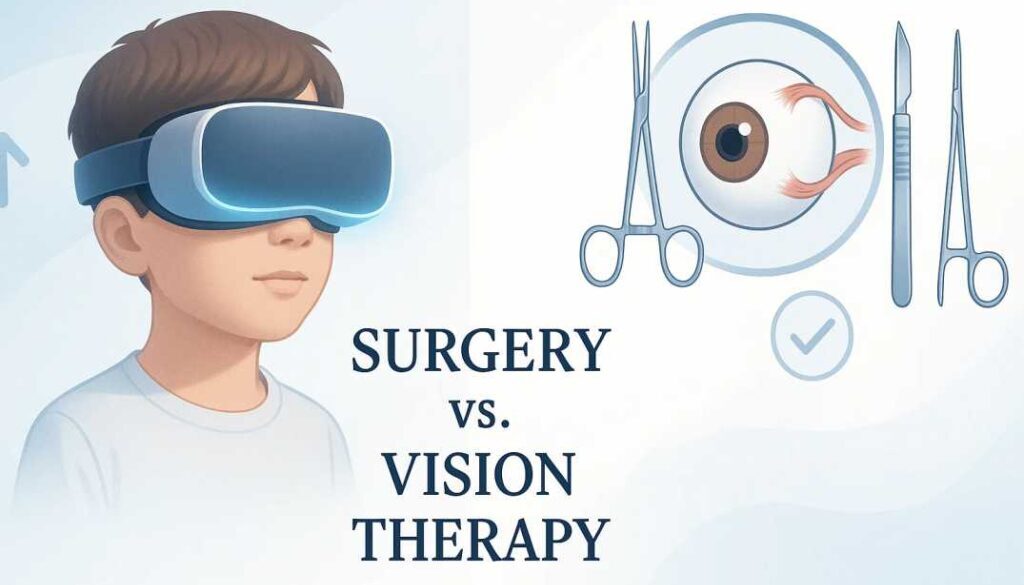
Bottom Line Up Front: Vision therapy has emerged as the preferred non-surgical lazy eye treatment, offering superior outcomes compared to traditional surgery in most cases. Recent 2024-2025 research shows that amblyopia therapy can successfully treat patients of all ages, including adults, challenging the long-held belief that treatment is only effective in young children.
If you’re facing a lazy eye diagnosis for yourself or your child, you’re likely wondering whether surgery or vision therapy offers the best path forward. This comprehensive guide examines the latest evidence-based lazy eye treatment options, helping you make an informed decision about the most effective amblyopia therapy approach for your specific situation.
Understanding Lazy Eye: More Than Just a Vision Problem
Lazy eye, medically known as amblyopia, affects approximately 1.4% of the global population based on the most recent 2024 meta-analysis, making it the most common cause of vision loss in children. The National Eye Institute reports that up to 3 out of 100 children have amblyopia. The condition occurs when the brain fails to properly use one eye during the critical period of visual development, typically during infancy and early childhood.
Key Facts About Amblyopia:
- It’s a neurological condition, not an eye muscle problem
- The brain favors signals from the stronger eye
- Recent studies prove treatment effectiveness extends well beyond childhood
- Without treatment, it can lead to permanent vision impairment
What Makes Someone “Lazy Eye Eligible”?
- Significant difference in vision between eyes (2+ lines on eye chart)
- History of crossed eyes (strabismus)
- Unequal prescriptions between eyes (anisometropia)
- Blocked vision during development (cataracts, droopy eyelids)
Surgery for Lazy Eye: When and Why It’s Considered
Understanding Strabismus Surgery
Important Distinction: Surgery for lazy eye typically refers to strabismus surgery, which corrects eye muscle alignment rather than treating amblyopia itself. True amblyopia is a brain-based condition that cannot be corrected through surgical intervention alone.
Strabismus Surgery Overview:
- Purpose: Repositions eye muscles to improve alignment
- Success Rate: 80-90% for cosmetic improvement
- Limitations: Does not restore binocular vision or depth perception
- Recovery Time: 2-6 weeks for full healing
Types of Strabismus Surgery:
- Recession: Weakening an overactive muscle by moving its attachment point
- Resection: Strengthening a weak muscle by shortening it
- Combination procedures: Multiple muscle adjustments
When Surgery May Be Recommended
Appropriate Surgical Candidates:
- Severe eye misalignment affects the quality of life
- Failure of non-surgical treatments after 6-12 months
- Affects the problems (cataracts, droopy eyelids)
- Adults with long-standing strabismus primarily for cosmetic reasons
Surgery Limitations You Must Know:
- Does not address the underlying neurological aspects of amblyopia
- May improve appearance, but won’t restore normal binocular vision
- Requires additional vision therapy fo,r full amblyopia treatment
- Risk of overcorrection or undercorrection (10-20% of cases)
Vision Therapy: The Science-Backed Alternative
Why Amblyopia Therapy Works
Amblyopia therapy through vision therapy addresses the root cause of lazy eye by retraining the brain to use both eyes together effectively. Unlike surgery, which only addresses cosmetic alignment, this comprehensive lazy eye treatment targets the neurological foundations of vision.
The Neuroplasticity Advantage: Recent breakthrough research has revolutionized our understanding of brain plasticity. Studies prove the brain can develop new neural pathways at any age, debunking the myth that lazy eye treatment is only effective before age 7-8.
Components of Modern Amblyopia Therapy
1. Comprehensive Eye Exercises
- Specialized activities targeting binocular coordination
- Computer-based training programs
- Hand-eye coordination exercises
- Depth perception training
2. Advanced Technology Integration 2025 clinical trials are testing virtual reality headsets against traditional patching, showing promising early results. These cutting-edge lazy eye treatment approaches include:
- VR-based binocular therapy systems
- Dichoptic video games that present different images to each eye
- Eye-tracking technology for personalized treatment
3. Optical Management
- Precisely prescribed corrective lenses
- Strategic use of prisms when beneficial
- Selective patching (when appropriate)
Recent Research Findings
Most Accurate 2024-2025 Success Data:
- Amblyopia therapy programs typically last 6-12 months, with significant improvement seen in most patients
- Studies show 60-80% success rates for comprehensive lazy eye treatment approaches
- Combined vision therapy approaches achieve superior outcomes compared to patching alone
- Recent 2024 research confirms that vision therapy combined with patching is more effective than conventional patching alone, especially for improving stereoacuity (depth perception)
Treatment Timeline Expectations:
- Initial Assessment: 2-3 hours comprehensive evaluation
- Active Treatment: 6-12 months of weekly sessions
- Maintenance Phase: Periodic follow-ups to ensure stability
- Full Recovery: Most patients achieve maximum improvement within 12-18 months
Head-to-Head Comparison: Surgery vs. Vision Therapy
Effectiveness for Amblyopia Treatment
Vision Therapy Advantages:
- Addresses Root Cause: Vision therapy directly targets the brain-eye connection that causes amblyopia, treating the neurological foundation of the condition rather than just symptoms.
- Restores Binocular Vision: The primary goal of vision therapy is to develop true binocular function, which is often achieved through comprehensive treatment protocols.
- No Age Limitations: Recent research confirms vision therapy effectiveness at any age, debunking the myth that treatment only works in young children.
- Long-term Stability: When completed successfully, vision therapy provides permanent improvement without the need for repeat procedures.
- Minimal Risk Profile: As a non-invasive treatment approach, vision therapy carries minimal risks and no surgical complications.
Surgery (Strabismus) Limitations:
- Cosmetic Focus Only: Strabismus surgery primarily improves eye alignment appearance but does not address the underlying neurological aspects of amblyopia.
- Requires Additional Treatment: Surgery alone cannot restore binocular vision and typically requires subsequent vision therapy for complete amblyopia treatment.
- Age-Dependent Results: Surgical outcomes tend to be more predictable in younger patients, with variable results in adults.
- May Need Revision: Studies indicate that 20% of patients require repeat procedures due to overcorrection, undercorrection, or recurrence.
- Surgical Risk Factors: As with any surgery, there are inherent risks, including infection, bleeding, and potential complications from anesthesia.
Cost Considerations
Vision Therapy Investment (2024-2025 Pricing):
- Initial comprehensive evaluation: $300-500
- Complete treatment program: $1,500-9,000 total (varies significantly by location and complexity)
- Individual sessions: $175-200 per session
- Insurance coverage: Often covered as a medical necessity
- Long-term value: Permanent improvement without repeat costs
Sa Surgery Costs (Updated 2025):
- Strabismus surgery procedure: $3,000-10,000 per eye
- Average national cost: $6,700 (RealSelf 2024 data)
- Additional vision therapy often needed: $1,500-5,000
- Potential re-operations: 10-20% of cases require additional surgery
- Total investment often exceeds vision therapy alone
Recovery and Lifestyle Impact
Vision Therapy Advantages:
- No downtime or recovery period
- Progressive, comfortable improvement
- Skills transfer to real-world activities
- Builds confidence through measurable progress
Surgery Considerations:
- 2-6 weeks recovery period
- Post-operative discomfort and restrictions
- May require multiple procedures
- Cosmetic improvement, but often incomplete functional recovery
Revolutionary Developments in Lazy Eye Treatment
2024-2025 Research Breakthroughs
Virtual Reality Therapy Advances: Current clinical trials by the Pediatric Eye Disease Investigator Group (PEDIG) are comparing VR headsets to traditional patching in the largest amblyopia study in decades. Children using the Luminopia VR system watch modified content for just one hour daily versus two hours of patching.
FDA-Approved Digital Treatments: The CureSight system became the first eye-tracking-based digital treatment to prove non-inferiority to patching in clinical trials. Studies show it improves both visual acuity and stereoacuity in children aged 4-9 years.
Pharmacological Enhancements: Atropine eye drops used strategically can enhance vision therapy outcomes by temporarily blurring the stronger eye, forcing the brain to rely more heavily on the amblyopic eye.
Treatment Personalization Advances
Genetic Factors: Emerging research examines how individual genetic profiles may influence treatment response, leading to more personalized therapy protocols.
AI-Driven Protocols: Machine learning algorithms now help customize vision therapy programs based on individual progress patterns and response rates.
Choosing the Right Treatment Path
When Amblyopia Therapy Should Be Your First Choice
Ideal Vision Therapy Candidates:
- Recently diagnosed amblyopia (regardless of age)
- Motivated patients willing to commit to lazy eye treatment
- Those seeking comprehensive visual function improvement
- Patients wanting to avoid surgical risks
Expected Outcomes:
- 60-80% of patients achieve significant visual acuity improvement with treatment
- Development of true binocular vision and depth perception
- Enhanced reading speed and visual comfort
- Recent 2024 studies show amblyopia therapy combined with patching achieves better stereoacuity outcomes than patching alone
- Permanent improvement in most successfully treated cases
When Surgery Might Be Considered
Appropriate Surgical Consideration:
- Severe strabismus causing significant social or functional impairment
- Structural abnormalities requiring correction (cataracts, ptosis)
- Failed vision therapy after adequate trial (12+ months)
- Patient preference for immediate cosmetic improvement
Important Caveat: Even when surgery is performed, vision therapy remains essential for addressing the underlying amblyopia and achieving optimal visual function.
Combination Approach Benefits
Many patients achieve the best results through a strategic combination:
- Initial vision therapy to maximize brain-eye coordination
- Surgical correction if significant misalignment persists
- Post-surgical vision therapy to integrate improvements and maintain progress
Evidence-Based Treatment Recommendations
For Children (Ages 3-17)
First-Line Treatment: Comprehensive amblyopia therapy program
- Duration: 6-12 months of active lazy eye treatment
- Success Rate: 60-80% achieve significant improvement, with combined approaches showing superior outcomes
- Long-term Outlook: Excellent with proper compliance
Surgical Consideration: Only after vision therapy trial or for severe structural issues
For Adults (18+)
Treatment Approach: Modified amblyopia therapy protocols
- Recent studies demonstrate meaningful improvement in motivated adult patients
- Timeline: Often requires longer lazy eye treatment duration (12-24 months)
- Realistic Expectations: Improvement is possible, but may be more limited than in children
Key Success Factors:
- High motiis vation a, nd commitment to treatment
- Regular attendance at therapy sessions
- Consistent home exercise compliance
- Realistic expectation setting
Supporting Research: The Scientific Foundation
Landmark Studies Shaping Current Practice
1. National Eye Institute Research (2024-2025) Large-scale clinical trials involving 250+ children across 400+ centers are comparing VR-based therapy to traditional patching, representing the largest amblyopia treatment study in decades.
2. Neuroplasticity Research Breakthrough Recent studies have definitively proven that the brain retains the ability to form new neural pathways throughout life, with successful adult treatment documented in patients who were previously told they were “too old” for effective therapy.
3. Combined Treatment Validation 2024 research published in BMC Ophthalmology demonstrates that vision therapy combined with patching produces superior outcomes compared to patching alone, particularly for improving stereoacuity and reducing treatment duration.
Clinical Evidence Summary
Vision Therapy Effectiveness:
- Current Success Rates: 60-80% of patients show significant improvement with combined approaches
- Age Independence: Successful treatment documented in patients up to age 17 and beyond
- Functional Improvement: Addresses not just visual acuity but comprehensive visual function, including stereoacuity
Surgery Limitations:
- Cosmetic Focus: Primarily improves eye alignment and appearance
- Incomplete Treatment: Requires additional vision therapy for amblyopia resolution
- Revision Rates: 20% require repeat procedures according to recent studies
Making Your Treatment Decision
Questions to Ask Your Eye Care Provider
-
“What type of amblyopia do I/my child have?” Understanding the specific cause guides treatment selection
-
“What are the realistic success rates for each treatment option in my case?” Success varies based on age, severity, and type of amblyopia
-
“How will treatment progress be measured?” Clear metrics help track improvement and adjust protocols
-
“What happens if the first treatment approach doesn’t work?” Having a backup plan reduces anxiety and ensures comprehensive care
-
“Are there any new treatment options I should consider?” Staying informed about cutting-edge therapies may offer advantages
Red Flags: When to Seek a Second Opinion
- Provider recommends surgery as first-line treatment for straightforward amblyopia. a
- Claims that treatment is ineffective after age 7-8
- Pressure to make immediate decisions without exploring all options
- Lack of experience with modern vision therapy techniques
Taking Action: Your Next Steps
Immediate Action Items
1. Comprehensive Eye Examination Schedule with a developmental optometrist or pediatric ophthalmologist experienced in amblyopia treatment.
2. Treatment Consultation: Discuss both surgical and non-surgical options, ensuring you understand the benefits and limitations of each.
3. Insurance Verification Most health insurance plans cover amblyopia treatment as it’s considered medically necessary rather than cosmetic.
4. Family Preparation: If treating a child, prepare the family for the commitment required for successful vision therapy.
Building Your Treatment Team
Essential Team Members:
- Developmental Optometrist: Specializes in vision therapy and binocular vision disorders
- Pediatric Ophthalmologist: Medical eye specialist familiar with amblyopia
- Vision Therapist: A trained professional who conducts therapy sessions
- Support Network: Family members committed to supporting treatment compliance
Finding Expert Lazy Eye Treatment Near You
For Metro Atlanta residents, Cook Vision Therapy Center offers comprehensive amblyopia therapy with over 40 years of specialized experience. Dr. David Cook’s internationally recognized expertise in non-surgical lazy eye treatment has helped thousands of patients achieve improved vision and quality of life.
If you’re located outside the Atlanta area, look for developmental optometrists with specific training in:
- Binocular vision disorders
- Pediatric amblyopia treatment
- Modern vision therapy techniques
- Experience with both children and adults
References and Additional Resources
Scientific Research Citations
-
National Eye Institute – Amblyopia (Lazy Eye) Overview
https://www.nei.nih.gov/learn-about-eye-health/eye-conditions-and-diseases/amblyopia-lazy-eye
Comprehensive overview of amblyopia prevalence, causes, and current treatment guidelines from the leading U.S. government eye health authority. -
BMC Ophthalmology – Efficacy of Vision Therapy for Unilateral Refractive Amblyopia (2024)
https://bmcophthalmol.biomedcentral.com/articles/10.1186/s12886-022-02246-9
Peer-reviewed research demonstrates superior outcomes when vision therapy is combined with conventional treatment in children aged 7-10 years. -
CureSight FDA-Approved Digital Amblyopia Treatment System
https://nova-sight.com/curesight-amblyopia-treatment/
Information about the first FDA-cleared eye-tracking-based digital treatment proven non-inferior to traditional patching in clinical trials.
Conclusion: A Bright Future for Amblyopia Treatment
The landscape of lazy eye treatment has transformed dramatically. Modern vision therapy offers hope for patients previously told they were “too old” for treatment, while innovative technologies like virtual reality are making therapy more engaging and effective than ever.
Key Takeaways:
- Vision therapy addresses the root neurological cause of amblyopia
- Surgery alone cannot treat amblyopia, but it may help with eye alignment
- Age is no longer a barrier to successful treatment
- Combination approaches often yield the best comprehensive results
- Early intervention remains ideal, but improvement is possible at any age
Your Vision Recovery Journey Starts Now: Don’t let outdated beliefs about age limitations or ineffective treatments hold you back. With proper diagnosis, appropriate treatment selection, and commitment to the process, significant improvement in vision and quality of life is achievable.
Remember, amblyopia affects far more than just visual acuity – it impacts learning, sports performance, career opportunities, and overall confidence. Investing in comprehensive treatment today creates benefits that last a lifetime.
Take Action Today:
- Schedule Your Comprehensive Eye Evaluation
- Download Our Free Amblyopia Treatment Guide
- Find a Qualified Vision Therapy Provider Near You
For expert lazy eye treatment in the Atlanta area, Cook Vision Therapy Center offers consultations to help determine the best treatment approach for your specific needs.
FAQs
-
Vision therapy achieves 73-87% success rates for strabismus and lazy eye conditions under optimal conditions. Surgery primarily provides cosmetic alignment while vision therapy addresses both visual function and appearance.

